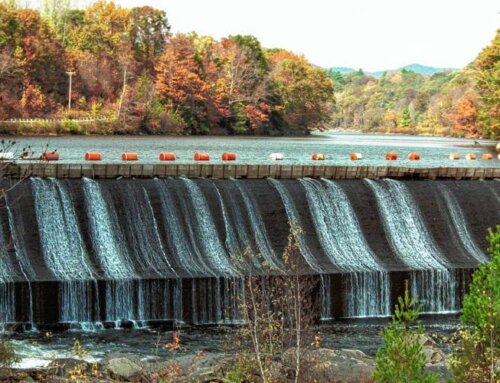The Connecticut River is a working river. It provides transportation, power, irrigation and recreation. The upper river started providing direct hydro power to the earliest settlements for their mills. The river floated the first log drives starting in the early 1700s to bring lumber to southern New England, drives that did not end until early in the 20th century.
Then the dams came to generate electricity. The first large hydro electric dam in the river above MA was built in Vernon in 1909. By the 1950s the Connecticut River powered the largest single hydro electric project in all of New England, the Fifteen Mile Falls hydro electric project comprised of Moore, Comerford and McIndoes dams.
How much electricity a hydro power facility can produce depends on the amount of water flowing in the river and the distance it falls from its high point to its low point. The power of the water produced by this drop in elevation is called head.
In the grand scheme of things the low point of the Connecticut River is zero feet above mean sea level (msl) since it is a direct tributary to Long Island Sound. It rises up at 4th Connecticut Lake at an altitude of 2,670 msl so the river has 2,670 feet of drop in elevation and nearly every foot of it contributes to the generation of power over the estimated 400 mile length of the river.
It is a small irony that the river drops 1,320 feet in its first 12 miles from 4th Lake to Lake Francis but not a watt of power is produced. The Connecticut Lakes are owned or managed by the major dam owner, TransCanada Hydro Northeast for water storage. Water is released from these lakes to provide flow during dry periods to spin the turbines in the down river dams.
Canaan Dam is the first power producing dam. The river is small here so the facility only produces one megawatt (MW) of power partially because it is a run of river facility. It does not pool water behind the dam for quick release but produces power from the natural flow of the river. In fact all of the dams on the river with the exceptions of Moore and Comerford stations are run of river dams.
Gilman Dam is next down river and produces 5 MW. Beyond that is Moore Dam. Moore and the next down river dam, Comerford are allowed to store large amounts of water behind them. When peaking power is needed the water is released quickly and drops 160 feet at Moore and 174 feet at Comerford. The configuration of these two dams mean large flows, big elevation drops equating into high head to make the station turbines spin like crazy. These two dams when added together can produce nearly 280 MWH of electricity when generating at full capacity. Together they produce more power than all of the other dams on the river combined.
Moving down river in order the MacIndoes, Ryegate, Wilder, Bellows Falls, Vernon, Turners Falls and Holyoke stations produce 254 megawatts of power when added together. The river gains more water as it moves to the ocean but over the entire distance of some 140 miles between McIndoes and Holyoke the river only drops 600 feet in elevation; more water maybe but less head so less power to spin turbines.
In the Turners Falls reach of the river there is another hydro producer that does not rely on damming the river but artificially creates head by pumping river water up to a reservoir at night when electric rates and usage are low and releasing it during daylight high use times when prices for electricity are high. The Northfield Mountain pump storage facility can produce 1,000 MW.
For all of the power the Connecticut River produces and even though its water keeps on flowing, there is no free lunch. Power production has its costs for the river. Dams change the river to a lake and cause silt to cover aquatic habitat on the river bottom behind the dams. Dams cause water temperature to increase and thereby dissolved oxygen levels to drop. Dams fragment the river and of course unless retrofitted with passage, stop fish migration cold. That said, with continued vigilance by CRC, resource agencies and cooperation by dam owners in the licensing process negative environmental impacts have been lessened by the terms of new licenses.
Our river lights our homes and offers us pastoral views, boating fun, cool playtime and fishing. You would think the river would be more than tired by the time it meets Long Island Sound but it just keeps on working even there. It provides important amounts of oxygenated water to an oxygen depleted Long Island Sound and helps keep LIS aquatic life from dying of hypoxia.
The Connecticut River does not end here but merges with the oceans of the world carrying messages from the North Country about the worth of our river.
# # # # # #
David Deen is River Steward for the Connecticut River Watershed Council. CRC has been a protector of the Connecticut River for more than half a century.







